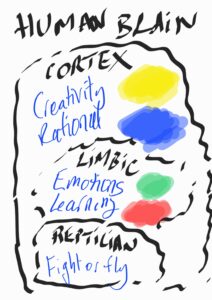It is always interesting to understand what motivates your counterpart. Let’s go through a short overview of the HBDI model designed by Ned Herrmann and how it helps to be better communicators with peers, employees, suppliers or customers.
Herrmann research helped him to segment human brain in 4 quadrants representing our thinking preferences. They act as filters in how we perceive our environment and people, and influence our behaviors and relationships.
The A quadrant (blue color) is RATIONAL, focused on facts. People are interested in numbers, financial aspects and generally on performance.
The B quadrant (green color) is CONSERVATIVE, more focused on HOW things are presented, organized. People dominated by this color are usually process and also facts orientated.
The C quadrant (red color) is FEELINGs, focusing on relationships. Representative of this color typically have to communicate and are people focused.
Finally, the D quadrant is about EXPERIENCING. Creative people and influencing leaders belong there. Have you ever met people having new ideas or elaborating new strategies all the time?

Now let’s take an example and see what language represents the best each thinking preference. Imagine you are in the process of negotiating to extend a contract.
Words typically used in each quadrant:
A: numbers, ROI within x years, performance, analysis,…
B: prevent risks, implementation, service quality, reliability,…
C : values, partnership, walk the talk, team, on both sides,…
D: Breakthrough, new, innovative, differentiating, new functionality, experiment,…
Note that each of us has various quadrants represented at different levels. And it is good as the world has more colors 😉. To conclude this short overview of the Whole Brain® model, listen carefully to the words used by your counterpart. It helps to understand its thinking preferences and motivation to decide/act. By doing this, you will be able to speak using the words matching your counterpart thinking preferences and be more efficient in your communication and negotiation.
Back to blog